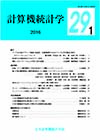Volume 29, Issue 1
Displaying 1-20 of 20 articles from this issue
- |<
- <
- 1
- >
- >|
-
2016 Volume 29 Issue 1 Pages Cover1-
Published: 2016
Released on J-STAGE: March 28, 2018
Download PDF (123K) -
2016 Volume 29 Issue 1 Pages App1-
Published: 2016
Released on J-STAGE: March 28, 2018
Download PDF (42K) -
2016 Volume 29 Issue 1 Pages i-
Published: 2016
Released on J-STAGE: March 28, 2018
Download PDF (89K) -
2016 Volume 29 Issue 1 Pages ii-
Published: 2016
Released on J-STAGE: March 28, 2018
Download PDF (32K)
Papers
-
2016 Volume 29 Issue 1 Pages 1-14
Published: 2016
Released on J-STAGE: April 12, 2017
Download PDF (4620K) -
2016 Volume 29 Issue 1 Pages 15-27
Published: 2016
Released on J-STAGE: April 12, 2017
Download PDF (3608K) -
2016 Volume 29 Issue 1 Pages 29-46
Published: 2016
Released on J-STAGE: April 12, 2017
Download PDF (2831K)
Reviews
-
2016 Volume 29 Issue 1 Pages 47
Published: 2016
Released on J-STAGE: April 12, 2017
Download PDF (1714K) -
2016 Volume 29 Issue 1 Pages 49-56
Published: 2016
Released on J-STAGE: April 12, 2017
Download PDF (2160K) -
2016 Volume 29 Issue 1 Pages 57-64
Published: 2016
Released on J-STAGE: April 12, 2017
Download PDF (2547K) -
2016 Volume 29 Issue 1 Pages 65-75
Published: 2016
Released on J-STAGE: April 12, 2017
Download PDF (9262K) -
2016 Volume 29 Issue 1 Pages 77-87
Published: 2016
Released on J-STAGE: April 12, 2017
Download PDF (5360K)
Report of Activities
-
2016 Volume 29 Issue 1 Pages 89-97
Published: 2016
Released on J-STAGE: April 12, 2017
Download PDF (1976K) -
2016 Volume 29 Issue 1 Pages 99-108
Published: 2016
Released on J-STAGE: April 12, 2017
Download PDF (1993K) -
2016 Volume 29 Issue 1 Pages 109-111
Published: 2016
Released on J-STAGE: April 12, 2017
Download PDF (1722K)
Editorial Board
-
2016 Volume 29 Issue 1 Pages 113-
Published: 2016
Released on J-STAGE: March 28, 2018
Download PDF (150K) -
2016 Volume 29 Issue 1 Pages 114-
Published: 2016
Released on J-STAGE: March 28, 2018
Download PDF (148K) -
2016 Volume 29 Issue 1 Pages 115-
Published: 2016
Released on J-STAGE: March 28, 2018
Download PDF (133K)
-
2016 Volume 29 Issue 1 Pages App2-
Published: 2016
Released on J-STAGE: March 28, 2018
Download PDF (35K) -
2016 Volume 29 Issue 1 Pages Cover2-
Published: 2016
Released on J-STAGE: March 28, 2018
Download PDF (28K)
- |<
- <
- 1
- >
- >|
